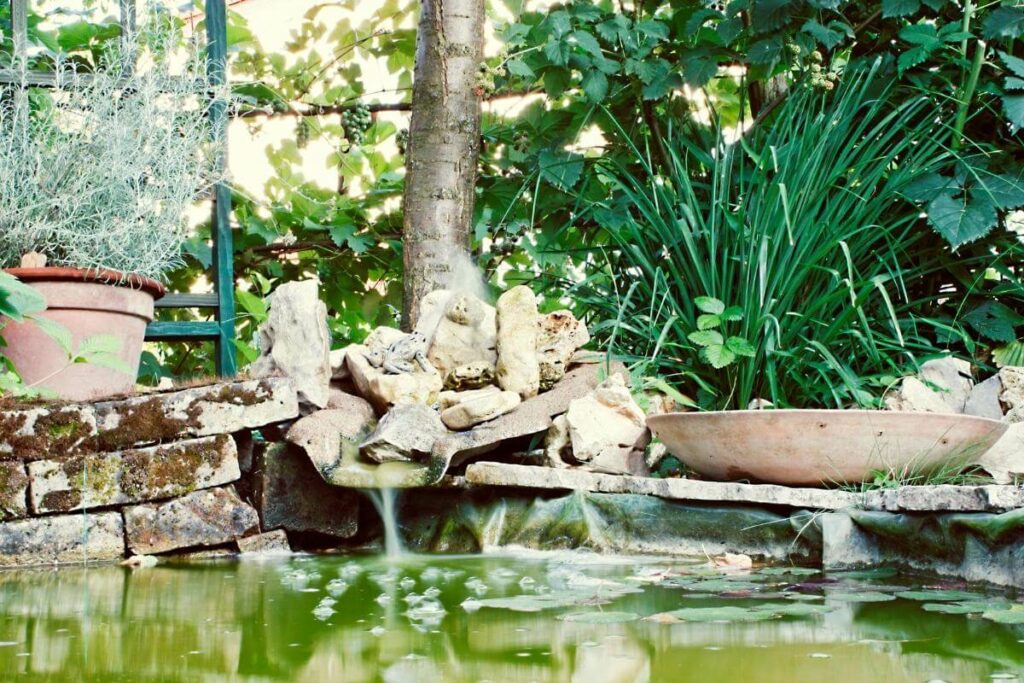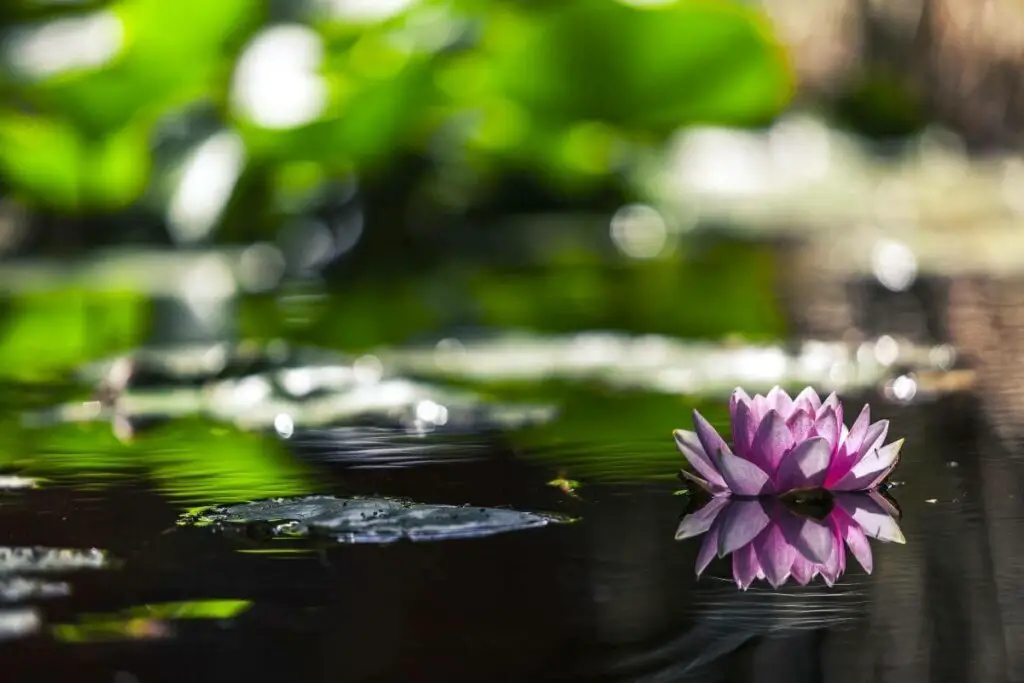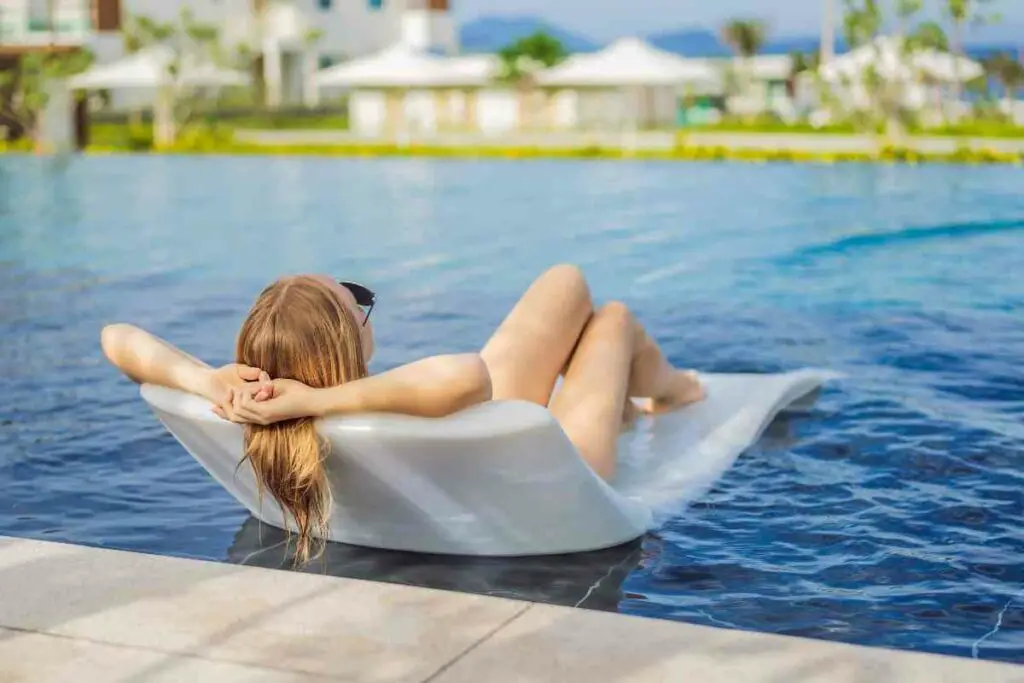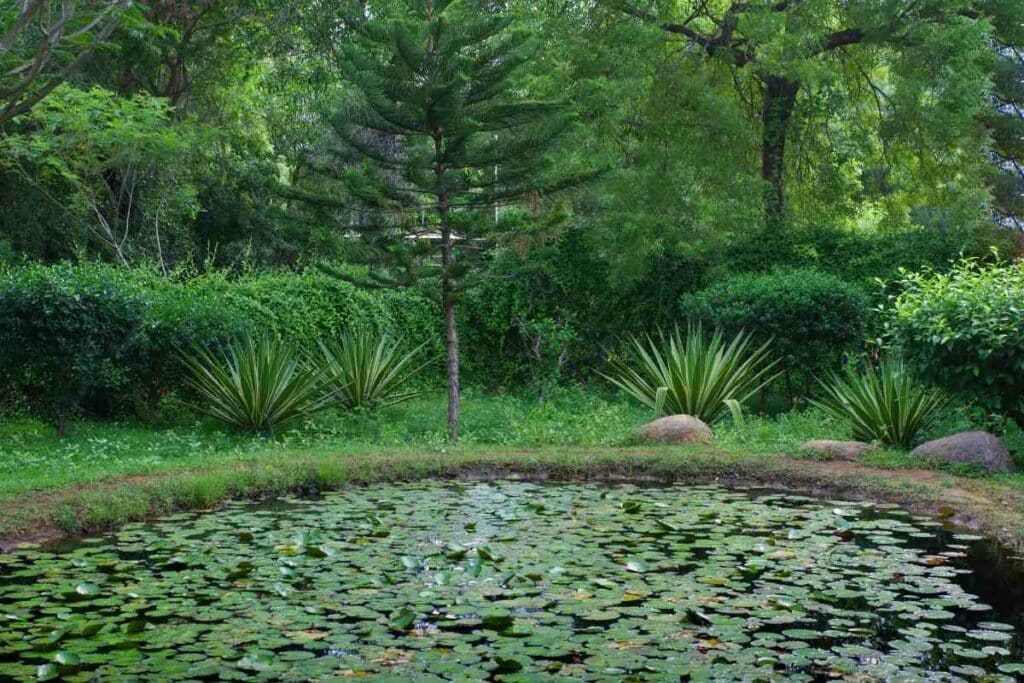Do your pond plants not seem to be doing as well as they should be?
Perhaps they are even dying off.
This is unfortunate, but common enough, so never fear!
The solution is likely a simple one, although you will want to act quickly.
The cause can be anything from a high temperature, to an incorrect pH level. You may have too many fish, or, more fish could be beneficial. Or, you may have too many – or too few – plants.
To learn 7 reasons your pond plants are dying, see below!
1. pH
As pond fish have a natural blood level of roughly 7 pH, a pond pH between 6.5-7.5 is ideal.
You can find out your pond pH by using a special testing kit (purchased online or in-store).
If your pond is too alkaline, AKA above 7.5 pH, you can address the problem with white vinegar.
You’ll need to relocate any fish in the pond first, however!
2. Too Hot or Too Cold
Plants are simple yet sensitive creatures, and the temperature of your pond will play a huge role in whether the plants thrive or die off.
In hot weather, it’s important that the pond has sufficient shade, so the plants and wildlife don’t overheat.

Along with this, improving the pond circulation can be quite helpful.
This enables the water to cool itself off. So, one solution can be a bigger and better water pump.
This will ensure that the water keeps moving and cooling itself off.
You can also add a waterfall or another water fixture; when it comes to cooling a pond off, these can really do the trick!
Another way to ensure that your pond stays cool is to plant just enough plants. Don’t overdo it, and same with the fish.
Balance is key when it comes to maintaining a cool enough pond.
What about in cold weather? This is harder to address since pond plants tend to naturally hibernate or die off in the winter. This is natural.
With this being said, you can outright purchase a pond heater, and this should suck in the cold water and then send out warm water.
Remember This: It should also ensure that the surface of the pond doesn’t freeze over. This is important, as it allows the pond to continue to circulate air!
3. Sunlight
As you may have guessed, one of the factors in the health of your pond plants is sunlight:
- Too much sunlight can be harmful, as it can cause your plants to overheat.
- Too little is equally inadvisable, as your plants will become less healthy and have less chlorophyll. It’s possible to gauge this simply by observing your plants, and how much/little your pond receives each day.
When plants have too much sunlight, they will turn yellow.

The same goes for if they receive too little sunlight; they will become yellow.
Ideally, your plants should not be in a shaded spot, unless you’re accustomed to very hot weather.
Most of the time, the plants are not getting enough sunlight.
Works Fine: Ponds tend to be healthiest when they are located somewhere sunny. For days that are unseasonably hot, you can always employ a large umbrella or something similar!
4. Toxic Water
Sometimes, the plants dying in your pond may be due to the water becoming toxic.
This can be due to a lot of things, one of which is the overcrowding and/or overfeeding of fish.

While the right amount of fish will positively affect a pond, too many fish can create an excess of waste as well.
In these cases, you will want to reduce the number of fish in your pond. Or, you could be overfeeding your fish.
This results in food being leftover, ultimately resulting in it rotting and dirtying the pond in general. So, how can you address this?
First off, make sure that your pond isn’t overcrowded. If it’s not, your next step is to make sure to feed your fish just enough, without excess food leftover!
If you’re concerned, you can also add extra healthy bacteria to help break down filth.
You can also employ a good old-fashioned biofilter!
5. Variety
What types of plants do you have in your pond?
Just a few, or a variety? A few plants are great and all, but more plants can be better.
These will not only consume waste as food, but they will provide shade for fish on days that are excessively hot or sunny.
Within reason, the more plants, the better!
Some of the best pond plants are creeping jenny, water lettuce, cardinal flower, horsetail, and pickerel.
They are known for their beauty and vitality, as well as for providing fish with shelter!
Plants that are the easiest to care for in a pond include those below!
Elephant Ear
Elephant Ear plants are some of the most popular plants for a pond.

If you plant one elephant ear, it will shortly grow more from the roots (similar to a cattail).
These are called pups, which you can carefully remove and plant elsewhere.
If you’re looking for a healthy, easy to care for pond plant, Elephant Ear plants will definitely do the trick!
Hornwort
Hornwort is a hardy, fast-growing plant that grows along the bottom of ponds.

It can last all year, even into a cold winter! It’s a grass-like plant that spreads like grass along a pond floor.
A word of caution only, be sure that the hornwort does not overgrow, or it can inhibit fish from swimming/trap them.
Fortunately, it’s fairly easy both to grow and to keep in check!
Cattail
Cattail is one of the hardiest pond plants out there and built for survival.
Many see their cattails year-round, and they even survive the winter! The stalks will disappear in cold weather, of course, but come spring, they will be right back.

As soon as the water begins to heat up, new roots and chutes will develop.
If you find yourself a bit overwhelmed with cattails, the only way to remove them is by pulling them up at the roots.
Usually, the plant is hardy enough that the remaining cattails won’t take any harm from it.
Fortunately: Cattails do not usually get too out of control, and they’re an excellent pond plant. If you are looking for a tough, healthy plant, cattails will surely do the trick!
Water Lettuce
Water lettuce, as its name implies, resembles a leafy plant atop the water.

It’s quite useful in ponds, as it naturally inhibits the growth of certain kinds of algae.
This is because it cleans the water, even going so far as to remove toxins, like cadmium and zinc.
This, it accomplishes with roots that go deep into the water!
Cardinal Flower

Cardinal flowers are highly-decorative, easy to care for water plants.
They grow along the edges of ponds, sporting elegant and colorful flowers.
What’s more, cardinal flowers attract both hummingbirds and butterflies.
They are perfect for a nature lover!
Creeping Jenny

Creeping Jenny is a beautiful, sprawling plant that’s easy to care for.
Typically, it roots around the edges of the pond and then floats across the surface beautifully.
It makes for great pond edging, and what’s more, it provides shade for any fish you might have in the water!
6. Fish Can Be Helpful
Does your pond have fish in it?
If not, this could be part of the reason for your plants dying.
Plants benefit dramatically from having waste to consume as food, and fish provide this amply (which is why a balance is also key).
So, how many fish should you have in your pond?

Recommended is one 6” fish for every 1000 gallons of water.
This being said, you can often get away with a few more fish than that. This is just a number to get you started.
The best fish for a pond are koi, fancy goldfish, catfish, plecos, etc.
Always Good Idea: If you’re looking to enhance the health of your pond, a handful of healthy, waste-eating fish should do the trick!
7. Chemicals In Ponds Are Harmful
If you have pond plants dying, another possibility is that there are too many chemicals in the pond.
Plants and fish alike will react negatively toward chemicals.

It’s important that any of the products that you use in your pond are all-natural. Otherwise, they may do more harm than good.
What if you think your pond has too many chemicals already?
There are certain products that can help. Normally, you combine these with some freshwater!
Along with this, to help keep chemicals or toxins down, additional plants may be useful (such as Water Lettuce, in particular).
Conclusion
So, now you know 7 reasons for pond plants dying. Almost certainly, one of these items on the list is the culprit.
Fortunately, there are plenty of steps you can take to help your plants become much healthier.
Did any of the above plants catch your eye?
Or perhaps you could use some more fish in the pond.
Address the problem as directed here, you can get your pond plants healthier than ever!
In Case You Missed It
- What Should I Put in the Bottom of My Wildlife Pond?
- Backyard Oasis With Pool: Creating a Relaxing Retreat in Your Backyard
- How to Find Pond Leak (Quick Method to Find the Leaks)
- Pool Ledge Lounger – Complete Buyers Guide
- Do Garden Ponds Overflow When It Rains
- How To Fill A Pond With Water (Complete Guide)






